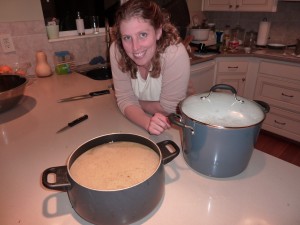At this very moment my wife is pulling the turkey bones and meaty remains out of a pot where she has had it and a handful of spices boiling out all the flavor and nutrients over the past few hours. My wife does this with the remains of foul, after straining the liquid she will freeze the it in plastic containers and then pull them out when it is time to make soups. It is just past thanksgiving and the winter is coming on; I don’t know about you but I love a good homemade soup on a cold winter day.
My wife says she’s too busy to write an article for me so I probed her for some info while she was working and I was doing the dishes. How many of you do this, or have considered doing this? My wife also loves saving ham bones with a little meat on them for flavor when making split pea soup; which I never enjoyed until getting married.
What is the difference between stock and broth? My wife wasn’t actually sure and did what many of us do; used both terms relatively interchangeably. I pulled these descriptions from thekitchn.com: “Stocks and broths both start off the same way: various kitchen scraps of vegetable, meat, and bone are slowly simmered to extract as much flavor as possible. For stock, it stops there — this is an unseasoned liquid that doesn’t taste all too great on its own, but makes a fantastic neutral base for soups, sauces, and other kitchen creations.”
“Broths, on the other hand, get some seasoning. We add salt, some other spices like black pepper, perhaps a splash of wine — all for the purpose of making this neutral stock taste delicious on its own. A more technical definition for broth would actually be “seasoned stock.” Now that the salt and other seasonings are added in, broth is tasty and satisfying.”
I’ve also seen my dad take leftover meat and spices, put them in cheese cloth and steep them in boiling water to create stock.
What are the nutritional contents of this material? From kitchenstewardship.com; Food for Thought: Health and Nutrition of Traditional Homemade chicken Broth/Stock “The food industry has all but taken the nutrition out of broth by cutting corners and adding…well, additives. Fake food.” Interesting. When I started researching this I didn’t think there would be that big of a difference; I just thought it was a useful way to utilize what is essentially left overs. Continuing farther down the article “The components of a healthy stock mostly come from the bones. In a properly prepared stock, the bones are allowed to sit in water with a bit of vinegar for an hour or so before heating. Have you ever done the experiment where you put an egg in vinegar, and after a while the shell gets completely soft? The vinegar, an acid, acts like our stomach acid and breaks down the calcium in the egg shell. In a stock, this calcium and other minerals from the bones are transferred directly to the water (which becomes broth/stock), and therefore into you. The best part is that it’s a more easily assimilated form of all the minerals than many other sources, including your supplements. Nutrition found in bone stocks: Calcium, Magnesium, Phosphorus, Other trace minerals, Gelatin, Collagen, Glycine.”
To put what you just read into understandable terminology “The health benefits (of homemade stocks and broths of course) are incredible, really. Here are just some of the advantages to preparing homemade stock: Boosts immune system, Aids digestion, Increases efficiency of protein use, Provides easily digestible minerals, including calcium, Can improve symptoms of: joint pain, common cold, peptic ulcers, tuberculosis, diabetes, muscle diseases, infectious diseases, jaundice, cancer, food allergies, colic, maldigestion, inflammatory bowel disease, osteoporosis, pain and inflammation, cramps, muscle spasms, delusions, depression, insomnia, irritability, hyperactivity, anxiety, palpitations, hypertension, high cholesterol, allergies….”
This article is much longer and had some amazing quotes from nutritional experts. Look up a recipe next time you have some bones you’re considering throwing out; it’ll be a great nutritional boost for your family and the flavor can never be matched by store bought. Just like a good steeped tea, this process extracts minerals and vitamins, among other useful commodities.
Jon
This is how my wife makes broth:
In a 6 quart pot I place chicken bones, 2-3 carrots, 2-3 stocks of celery, one onion, 1-2 bay leaves, one large clove garlic sliced, and any herbs or seasonings you prefer. I generally use a few sprigs of dried rosemary, thyme, ginger, marjoram, and sometimes mustard powder. Have fun with it!
Brita


Leave a Reply